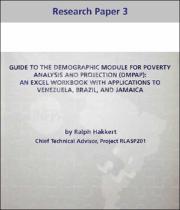Please use this identifier to cite or link to this item:
https://repositorio.ipea.gov.br/handle/11058/13954Full metadata record
| DC Field | Value | Language |
|---|---|---|
| dc.contributor.author | Hakkert, Ralph | - |
| dc.coverage.spatial | Brasil | pt_BR |
| dc.coverage.spatial | Jamaica | pt_BR |
| dc.coverage.spatial | Venezuela | pt_BR |
| dc.date.accessioned | 2024-06-03T19:45:40Z | - |
| dc.date.available | 2024-06-03T19:45:40Z | - |
| dc.date.issued | 2007-08 | - |
| dc.identifier.citation | HAKKERT, Ralph. Guide to the demographic module for poverty analysis and projection (DMPAP): an Excel workbook with applications to Venezuela, Brazil, and Jamaica. Brasília: Ipea: UNFPA, 2007. (Research Paper ; 3). Disponível em: https://repositorio.ipea.gov.br/handle/11058/13954 | pt_BR |
| dc.identifier.uri | https://repositorio.ipea.gov.br/handle/11058/13954 | - |
| dc.description.abstract | Tradicionalmente, os economistas projetam a incidência da pobreza como uma função direta do crescimento econômico, utilizando a chamada elasticidade renda-pobreza, um índice empiricamente medido que quantifica quanto a redução da pobreza ocorre para cada aumento de 1% na renda per capita de um país. Se a elasticidade for alta, a pobreza responde fortemente ao crescimento econômico, possivelmente porque a maioria dos pobres está vivendo logo abaixo da linha de pobreza. Se for baixa, mesmo grandes aumentos na renda per capita serão relativamente ineficazes na redução da pobreza. O crescimento econômico pode não ser neutro em termos de seus efeitos distribucionais e pode na verdade exacerbá-la ao piorar a distribuição de renda, mas mesmo que não altere a distribuição de renda, a redução da pobreza resultante de 1% de crescimento geralmente é inferior a 1% (ou seja, a elasticidade é menor que 1), especialmente se a distribuição inicial for muito desigual. Na América Latina, em particular, as elasticidades renda-pobreza tendem a ser relativamente baixas, exatamente por causa das enormes desigualdades de distribuição encontradas nesta região. | pt_BR |
| dc.language.iso | en-US | pt_BR |
| dc.publisher | Instituto de Pesquisa Econômica Aplicada (Ipea) | pt_BR |
| dc.title | Guide to the demographic module for poverty analysis and projection (DMPAP) : an Excel workbook with applications to Venezuela, Brazil, and Jamaica | pt_BR |
| dc.type | Livros | pt_BR |
| dc.rights.holder | Instituto de pesquisa econômica aplicada (Ipea) | pt_BR |
| dc.source.urlsource | https://www.ipea.gov.br/ | pt_BR |
| dc.location.country | BR | pt_BR |
| dc.description.physical | 56 p. | pt_BR |
| dc.subject.vcipea | IPEA::Política Econômica. Política Social. Planejamento::Política Social | pt_BR |
| dc.rights.license | É permitida a reprodução deste texto e dos dados nele contidos, desde que citada a fonte. Reproduções para fins comerciais são proibidas. | pt_BR |
| dc.subject.keyword | Combate à pobreza | pt_BR |
| dc.subject.keyword | Projeções de população | pt_BR |
| ipea.description.additionalinformation | (Research Paper; 3) | pt_BR |
| ipea.description.additionalinformation | Financiamento: IPEA/UNFPA Project RLA5P20: Regional support to population and development in the implementation of the MDGs in the LAC Region | pt_BR |
| ipea.access.type | Acesso Aberto | pt_BR |
| ipea.rights.type | Licença Padrão Ipea | pt_BR |
| ipea.englishdescription.abstract | Traditionally, economists project the incidence of poverty as a direct function of economic growth, using the so-called income-poverty elasticity. This is an empirically measured index that quantifies how much poverty reduction occurs for every 1% increase in a country's per capita income. If the elasticity is high, poverty responds strongly to economic growth, possibly because most of the poor are living just below the poverty line. If it is low, even large increases in per capita income will be relatively ineffective in reducing poverty. Economic growth may not be neutral in terms of its distributional effects and may actually exacerbate it by worsening income distribution. However, even if it does not alter income distribution, the resulting reduction in poverty from a 1% growth is generally less than 1% (i.e., elasticity is less than 1), especially if the initial distribution is very unequal. In Latin America, in particular, income-poverty elasticities tend to be relatively low, precisely because of the huge distributional inequalities found in this region. | pt_BR |
| ipea.researchfields | N/A | pt_BR |
| ipea.classification | Desenvolvimento Social | pt_BR |
| Appears in Collections: | Desenvolvimento Social: Livros | |
Files in This Item:
| File | Description | Size | Format | |
|---|---|---|---|---|
| Guide_to_the_demographic_module_for_poverty_analysis_and_projection_(DMPAP).pdf | 2.61 MB | Adobe PDF |  View/Open |
Items in DSpace are protected by copyright, with all rights reserved, unless otherwise indicated.

